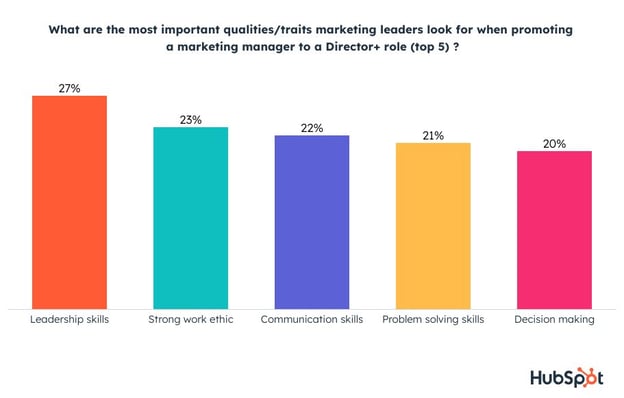The Marketing Executive’s Playbook: How Marketers Can Work & Level-Up Like 500+ Leaders in 2023 [New Data]
One of the best ways to be successful in your career is to learn from those who’ve mastered the craft.
And when it comes to your marketing strategy, there’s nobody better to learn from than established industry leaders, like SEO wizard Neil Patel.
To get a sense of how leaders are feeling wrapping up the year and planning for 2023, we surveyed 500 of them on:
- Goals & Growth Strategies
- Marketing Leader KPIs
- Marketing Leader Challenges
- Recession Preparations
- Company Culture, Turnover, and Quiet Quitting
- Marketing Career Playbook: How to Excel Like an Executive
- What Marketing Leaders Do All Day
Let’s start with the goals marketing leaders are prioritizing for 2023, and go over the growth strategies they plan on using to achieve them.
Marketing Leader Goals & Growth Strategies
What are Marketing Leaders’ Goals for 2023?
The top two goals marketing leaders have for 2023 center around developing a deeper connection with their customers – specifically, getting to know them better and improving customers’ understanding of their products/services.
Improving sales and marketing alignment, boosting revenue and sales, and building relationships with customers are also top priorities for marketing leadership going into 2023.
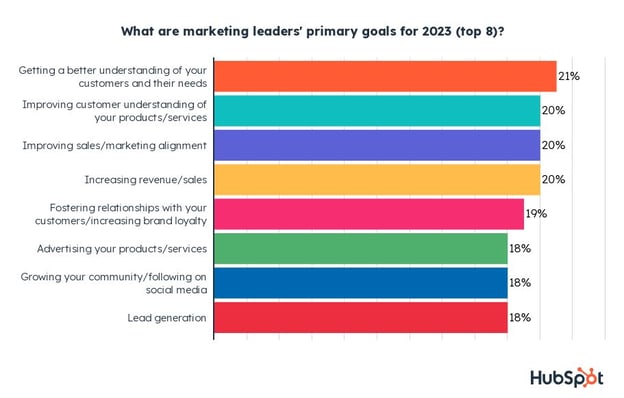
Now that we know their goals, let’s dive into the strategies marketing leaders will use to achieve them.
Which Marketing Strategies are Most Effective?
With customer-centricity being a top priority for marketing leaders going into 2023, it’s no surprise that giving customers the best possible experience with your brand is the strategy leaders say is most effective for driving business growth.
Interestingly, all the other top strategies lead right back to it.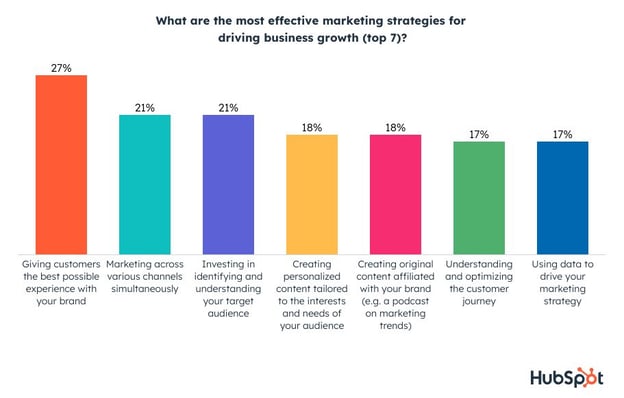
For example, omnichannel marketing is all about meeting your customers where they are and creating a smoother customer journey.
Investing in identifying and understanding your target audience is key to giving customers a great experience with your brand. After all, you need to know who they are to pinpoint how your product or service can help them.
Creating personalized content tailored to your customers’ interests also requires a deep understanding of your customers, and is crucial to providing them with a uniquely unforgettable experience.
Publishing original content affiliated with your brand, like a podcast or blog, is another way to build brand awareness, loyalty, and provide value to your customers.
And understanding how all of the above play into the customer journey and finding ways to optimize it is a key component to providing an incredible customer experience.
Of course, none of this would be possible without a data-driven marketing strategy, which helps you understand your customers, adapt to their interests and needs, and ultimately forge meaningful connections with them.
Unfortunately, many companies are currently experiencing a crisis of disconnection with their customers. More than half of marketers don’t know basic demographic information about their target audience, their marketing data isn’t well integrated with the tools they use, and their customers’ lives are changing at a rapid pace.
Working with disconnected and incomplete data – combined with rapid changes in consumer attitudes and behaviors – is leaving marketers scrambling to keep up.
This lines up with the key finding of our Marketing Trends 2023 Report: marketers who embrace a data-driven approach and use that data to pivot their marketing strategy as consumers change will win in 2023.
Not only that, but marketing leaders say having to constantly pivot their marketing strategy is the biggest challenge they are currently facing. They also confirm that the most impactful thing marketers (individual contributors) can do in their role is be prepared to pivot their marketing strategy due to unforeseen events.
Judging by the last few years, and with a recession looming in 2023, being prepared to pivot may only become more important.
Now that we know the top strategies marketing leaders are using, let’s dive into which metrics they use to track their success.
Marketing Leader KPIs
While sales unsurprisingly takes the top spot as the most important metric marketing leaders track, customer retention comes in second, emphasizing the importance of the customer experience.
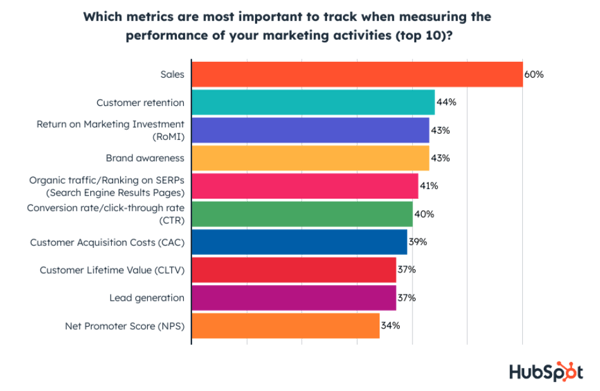
Return on marketing investment, brand awareness, and organic traffic/SERP ranking are also top KPIs marketing leaders are keeping tabs on.
Speaking of organic traffic, 89% of leaders say their company uses a blog/website for marketing purposes.
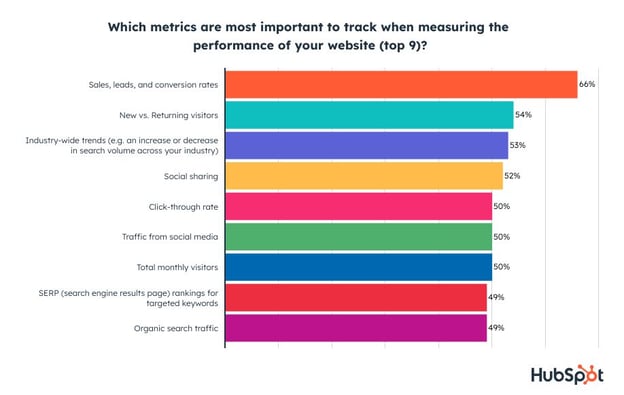
Next, let’s check out the top challenges marketers are facing now and the challenges they expect to see in 2023.
Marketing Leader Challenges
The biggest challenge marketing leaders face is having to pivot their marketing strategy due to major events, like a pandemic or recession. Hiring top talent, generating revenue, increasing competition, and measuring the ROI of marketing activities also top the list.
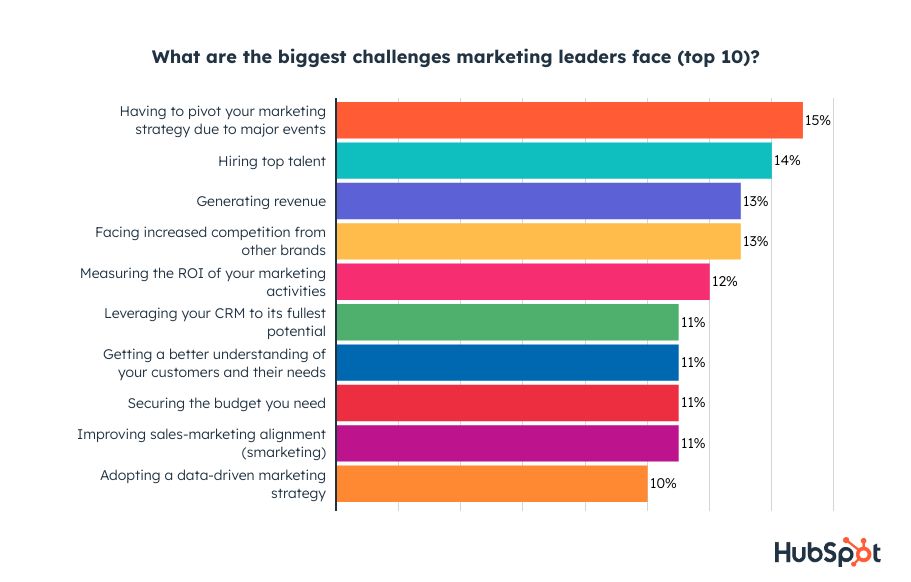
If you’re surprised pivoting is such a challenge for marketing leaders, consider this. Back in 2021, over half of marketers pivoted their strategy after it went into motion, and 83% of those who pivoted had to change course two to four times in one year.
Fast forward to 2022 and 20% of marketers have already pivoted this year due to a potential recession, hinting that we may see similar turbulence next year.
When it comes to the challenges marketers expect to face in 2023, securing budget and generating revenue are tied for #1 (both cited by 14% of respondents), followed by improving sales/marketing alignment (13%), having to pivot due to major events (13%), and increased competition (12%).
The fact that securing budget for 2023 is such a pressing challenge signals marketing leaders may be concerned about the looming economic slowdown – so let’s take a dive into how leadership is preparing for a recession.
Recession Preparation
Whether we are or aren’t in a recession, eight in 10 leaders have already taken steps to plan or prepare for one.
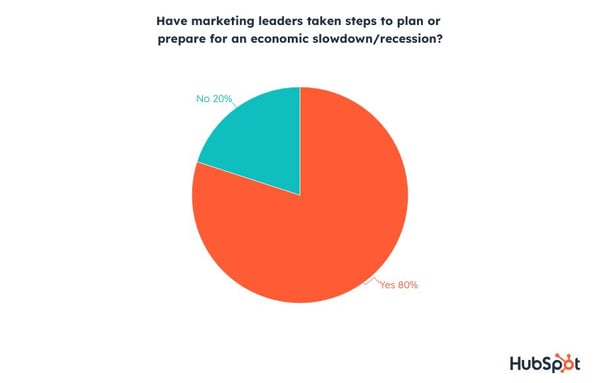
On top of that, 49% of marketing leaders say a recession in 2023 would impact their marketing activities – so let’s take a look at what they might do when faced with tough economic times: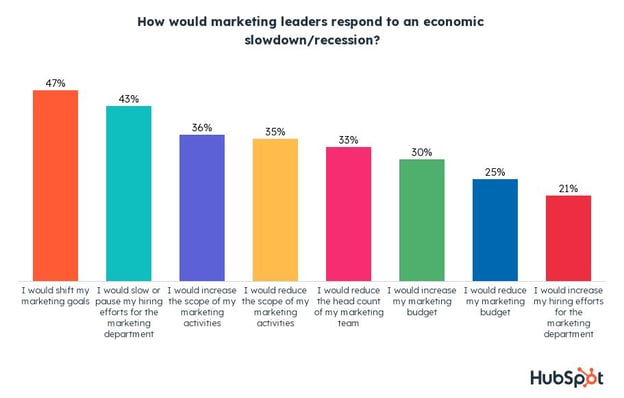
In short, marketing leaders are conflicted.
36% of marketing leaders say they would increase the scope of their marketing activities, while about the same amount would reduce it.
Similarly, 30% would increase their marketing budget in a recession, while 25% plan to trim it down.
This means that if you decide to reduce your marketing activities due to the recession, you can expect some of your competitors will be stepping up their marketing efforts and winning market share.
But sometimes there’s no way around cutting your marketing budget, so let’s see how marketing leaders plan to reduce costs in a recession.
The Top Strategies for Cutting Marketing Costs
Marketing leaders say the most effective strategies for cutting marketing costs are leaning into earned (free) media, leveraging automation or AI, looking for cheap emerging marketing opportunities, leaning into organic marketing channels, and shifting investment into channels/tools with high ROI.
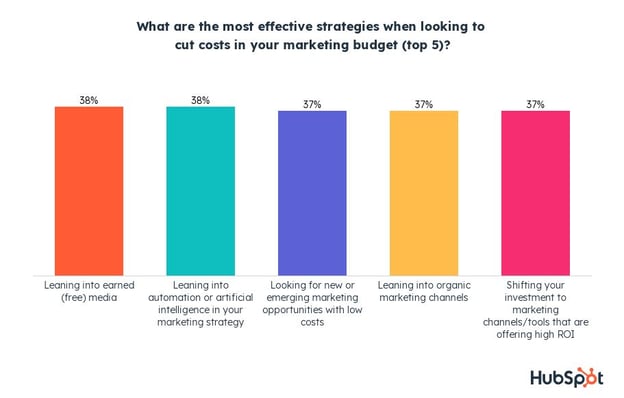
Regardless of the strategies you use, when times are tough, you may have no choice but to pull back on some of your marketing channels — so let’s see where marketing leaders most expect budget cuts if a recession hits.
Where Will Marketing Leaders Cut Costs In A Recession?
If a recession occurs, 1 in 4 marketing leaders expect to see budget cuts in their paid social media content, followed by organic social content, print ads, email marketing, and video content.
Keep in mind these are among the most popular and most effective channels, so a broader pullback in marketing spend may affect them disproportionately, simply due to the fact more marketers use them in the first place.
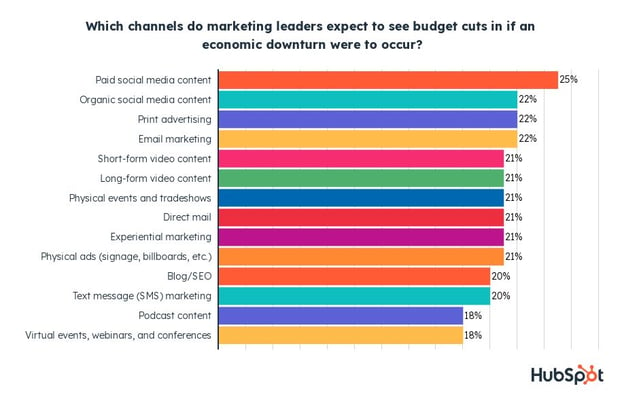
On the other hand, marketing leaders least expect virtual events, podcasts, SMS, and physical ads to see budget cuts in a recession – possibly because these are used less often – though around 1 in 5 still think these channels would be on the chopping block.
Interestingly, blogs are also among the least likely to be cut, despite being the second most popular marketing channel in 2022, meaning they will see less of a pullback than other equally popular marketing channels like social media, email, and video.
Another major area likely to see cuts in a recession is hiring, so let’s see how marketing leaders are planning out their hiring strategy for 2023.
How Will A Recession Affect Hiring?
Before we talk about next year, let’s look at how the looming recession has already impacted hiring in 2022.
46% of marketing leaders say their company has decreased hiring efforts due to the potential for a recession – yet another 36% say they increased hiring efforts.
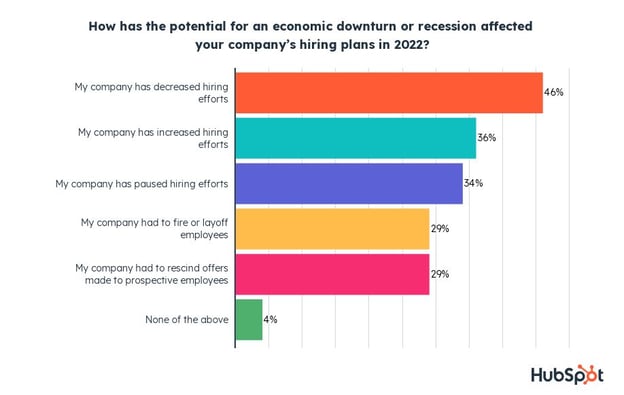
34% of marketing leaders say their business has paused hiring efforts in 2022, and 29% have had to fire, lay off, or rescind offers made to employees.
When it comes to 2023, 42% of marketing leaders say the potential for recession has affected their hiring plans for next year. Among them, 54% plan to decrease hiring efforts in 2023, while 46% will look to increase their hiring.
Additionally, 28% of those whose hiring plans are affected by the recession plan to fire or lay off employees in 2023.
Even though marketing leaders are conflicted on whether to hire more or less in 2023, it’s clear that the chance of recession has a meaningful impact on hiring plans.
How Do Marketing Leaders Think a Recession Will Impact Consumers?
About half of marketing leaders say consumers will spend less on non-essential items and will be more careful with how they spend money in an economic slowdown.
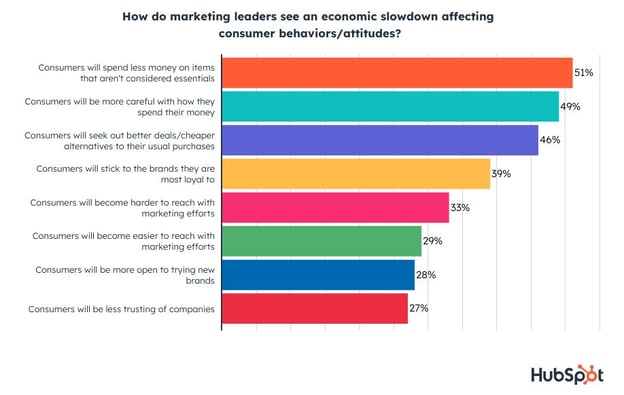
When it comes to brand loyalty, marketing leaders are conflicted. 46% think consumers will seek out cheaper alternatives to their usual purchases and 28% of marketing leaders think consumers will be more open to trying new brands in a recession.
On the other hand, 39% of marketing leaders say shoppers will stick to the brands they are most loyal to.
Marketing leaders are similarly conflicted when it comes to reaching consumers with marketing content. 33% think it will be harder to reach consumers, while 29% think it will become easier, while 27% think consumers will be less trusting of companies altogether.
With all these conflicting data points, it can be hard to know what the right move is when a recession comes along. Remember, the biggest challenge marketers are facing is having to pivot their marketing strategy due to major events, and much like a pandemic, a recession is one of those events that will shake things up.
The most valuable action you can take now is make a plan ahead of time. When your competitors reduce their marketing spend due to economic factors, will you use that as an opportunity to step up? How will you adapt your messaging to resonate with what your consumers are going through and build trust in a challenging time?
Now that we’ve seen how consumers and marketing leaders might react to a recession, let’s dive into how marketing budgets looked in 2022, and how leadership expects them to change in 2023.
Marketing Budget Breakdown
On average, marketing leaders say 33% of their overall company budget goes toward marketing. Over half (52%) of marketing leaders expect the percentage of their overall company budget going to marketing to increase in 2023, while 41% expect it to stay the same.
The average marketing budget per quarter in 2022 was $404K, topping out at $721K in Q3, and shrinking to a low of $456K in Q4.
If those numbers seem high, keep in mind that results can be skewed by a few large companies — the median budget per quarter was $15K.
Let’s take a look at the average budget for 2022 by company size to help you make a better comparison with your business:
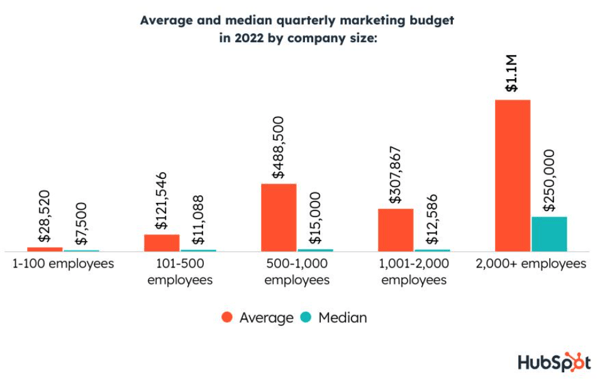
When it comes to how that budget is spent, on average, 61% of marketing activities are conducted internally, while 39% are done by an outside agency.
How Executives Think About Company Culture
92% of marketing leaders say company culture is moderately to extremely important for their teams to reach their goals. So which aspects of company culture are most important for marketers to succeed?
Healthy work-life balance, freedom to work autonomously, and supportive management are the most important, followed by the ability to make a meaningful impact in their work and a strong sense of purpose.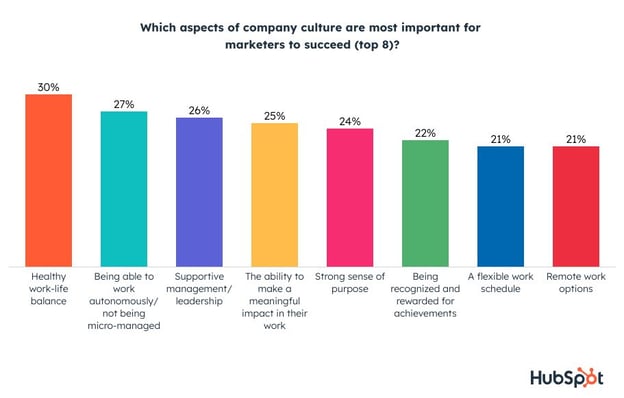
When it comes to why marketers leave their positions, leaders believe lack of competitive pay, unsupportive management, lack of work-life balance, too much micromanaging, and lack of career growth opportunities are the biggest drivers of turnover.
Speaking of employees leaving their positions, 41% of marketing leaders say the turnover rate at their company is high this year. So what happens when a marketing team has high turnover?
Marketing leaders also say the biggest effect of high turnover is that it causes more turnover, harms performance, decreases productivity, lowers morale, and wastes their hiring budget.
But high turnover also affects the company as a whole. In addition to the above impacts, marketing leaders say high turnover makes it harder to hire top talent, harms overall company performance, taints the company’s reputation, and even harms the company’s product/service.
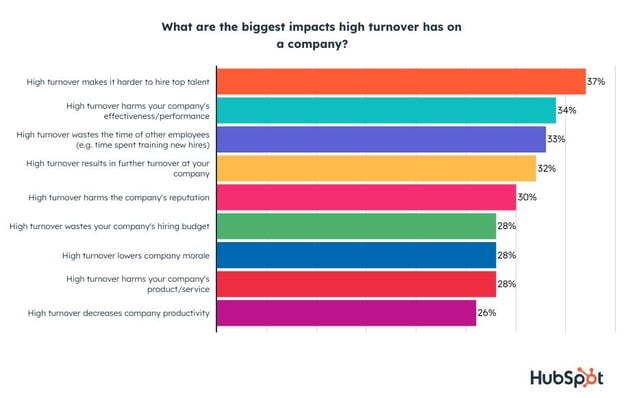
High turnover is clearly something that can cause significant damage to both a marketing team and the greater company, but another related trend can also be a challenge for marketing leaders – quiet quitting.
How Do Marketing Leaders Feel About Quiet Quitting?
Our survey shows that 73% of marketing leaders are familiar with quiet quitting, and 2 in 3 say their leadership team has explicitly discussed how to address it. On top of that, over half of marketing leaders say they are concerned about quiet quitting.
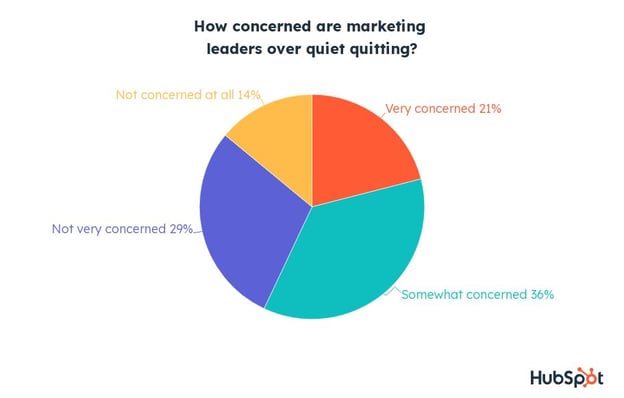
Considering marketing leaders think 17% of their employees are engaged in quiet quitting, this level of concern makes sense.
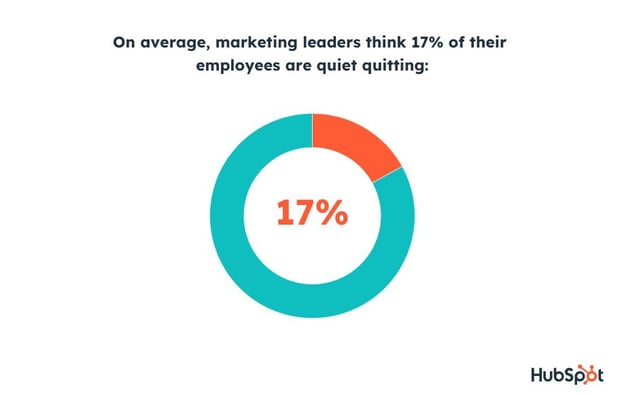
But before we dive deeper into how management feels about quiet quitting, why they think it happens, and whose responsibility it is to address, let’s take a look at how marketing leaders define quiet quitting.
Unsurprisingly, marketers in leadership roles don’t look fondly on the trend, with 64% of marketing leaders saying quiet quitting is a reflection of an employee’s poor work ethic as opposed to setting healthy boundaries.
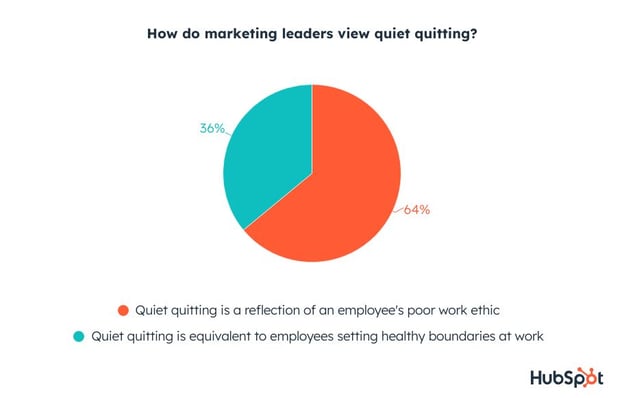
On top of that, 79% of marketing leaders say quiet quitting will impede an employee’s career growth.
While 77% say quiet quitting is unacceptable at work, 57% of marketing leaders admit quiet quitting is happening to some degree in their organization.
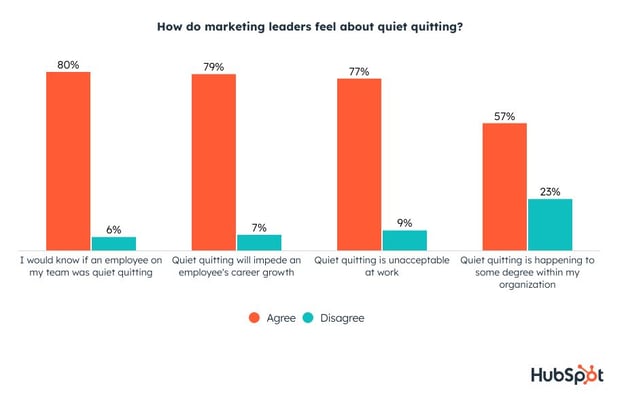
Why Leaders Think Employees Quiet Quit
77% of marketing leaders believe quiet quitting is their responsibility to prevent.
And. 73% of marketing leaders agree that the quality of an employee’s relationship with their supervisor is the most important factor in determining whether they engage in quiet quitting. Additionally, 63% of marketing leaders say quiet quitting is a reflection of poor management and leadership.
Marketing leaders say the top strategies are to prevent quiet quitting involve motivating employees with rewards, recognizing hard-working employees, offering workers career development opportunities, supporting workers’ mental health, emphasizing work-life balance, and offering flexible work schedules.
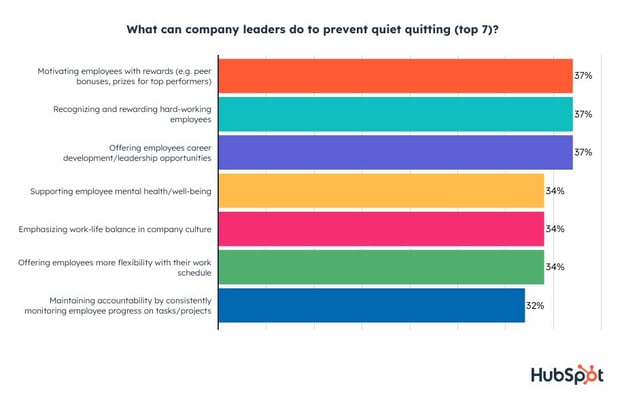
Speaking of the importance of career development opportunities, we asked marketing leaders how marketers can make the greatest impact in their roles, the top skills marketers need, and how they can get promoted – so let’s take a look at the marketer’s career playbook.
The Marketer’s Career Playbook: How to Go from Individual Contributor to Marketing Leadership
If you’re a marketer looking to excel in your career, consider this your road map to success.
We’ll start by looking at the top skills marketers should focus on for career growth, then dive into how you can make the greatest impact and get promoted at each level of your career – whether you’re an individual contributor, manager, or aspire to be a company leader.
What Skills Should Marketers Focus on for Career Growth?
Marketing leaders say the top five skills marketers should focus on to grow their careers are social media marketing, data analysis, CRM skills, people management skills, and strategic planning.
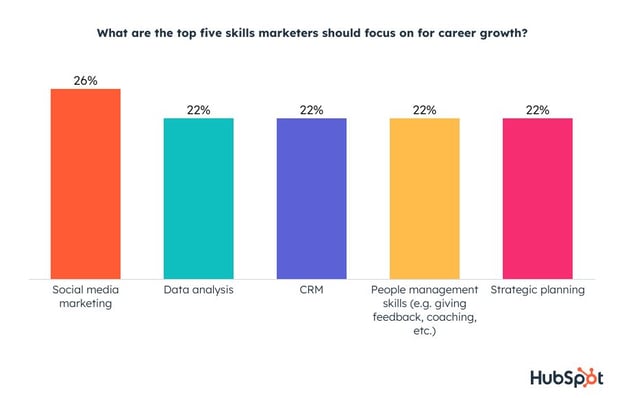
Now that you know the most important skills, let’s see how marketers working as individual contributors can make the greatest impact in their role.
How Marketers (or ICs) Can Make the Greatest Impact in Non-Management Roles
The best way executives say marketers can make an impact in their role is by being prepared to pivot their marketing strategy in response to major events. Considering this is the top challenge marketing leaders are currently facing, it isn’t surprising that agile marketers are highly valued by leadership.
ICs (or individual contributors) can also make a meaningful impact by having a clear understanding of the needs and interests of their target audience as well as their company’s products and services.
If you’re looking to move to a more senior marketing role, we’ll take a look at what you can do to get promoted next.
How Mid-Level ICs Can Move to a Senior Level
Being able to pivot in response to major events is still the top skill, but industry expertise, short and long-term planning skills, being able to keep up with trends, and a clear understanding of your brand’s values are also key to promotion.
The most important traits marketing leaders look for when promoting marketers to senior positions are leadership, communication, problem-solving skills, critical thinking, and creativity.
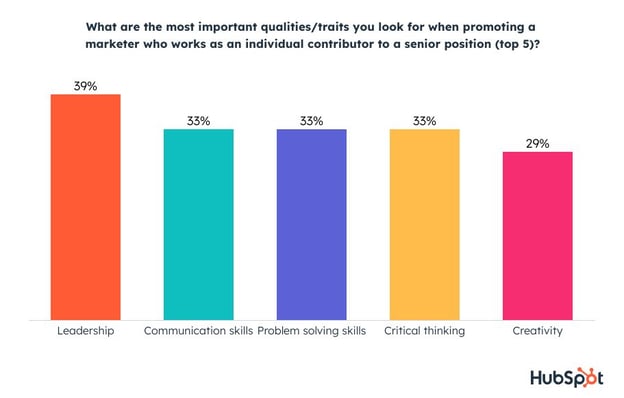
Next, let’s see what leaders are looking for when promoting marketers to manager roles.
How Marketers Can Get Promoted to Manager
If you’re looking to make the jump to manager, leaders are looking for marketers who can build trust and rapport within their team, bring people together to solve problems, pivot their marketing strategy in response to change, and evaluate performance fairly and offer constructive feedback.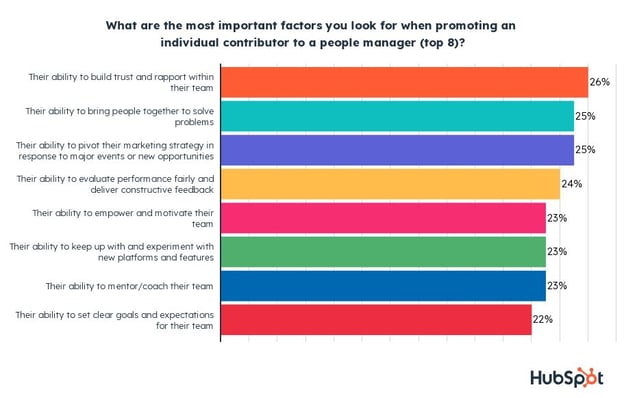
The top traits leaders look for in managers are similar to those they look for in individual contributors, with a few key differences. Leadership and communication skills still come first, but teamwork, accountability, and the ability to empower others become highly important for managers.
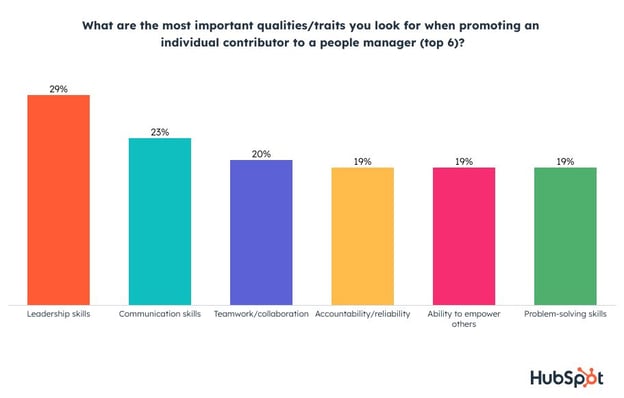
So now that you’re on your way to becoming a people manager, here’s how marketing leaders say managers can make the greatest impact.
How Marketing Managers Can Make the Greatest Impact
To make the most meaningful impact, our surveyed executives say marketing team managers need to empower their team, help them exceed their goals, solve problems, set clear goals and expectations, and build relationships with more senior leadership.
While successful managers and individual contributors share many skills, managers are evaluated based on very different criteria – let’s see exactly how marketing leaders measure managers.
How Leaders Measure a Marketing Manager’s Performance
Marketing leaders measure managers by their team’s productivity, followed by feedback from their direct reports, and how engaged managers are with their team.
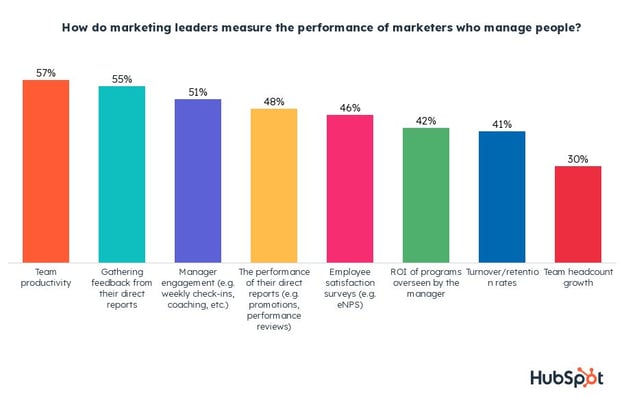
The performance of their direct reports and employee satisfaction surveys are also some leading ways leadership measures the success of a manager.
70% of marketing leaders also regularly hold skip-level meetings, gathering feedback directly from the employees supervised by a manager.
If you’re still interested in climbing up the corporate ladder, let’s take a look at how to get promoted from manager to a leadership role.
How Marketers Can Get Promoted to Leadership Roles
When it comes to promoting a manager to a leadership position, marketing leaders look for the ability to plan for the long and short term, set clear goals and expectations, pivot in response to major events, and bring people together to solve problems.
Being able to keep up with new platforms and trends, as well as evaluate performance fairly and offer constructive feedback are also key to getting leadership roles.
When it comes to the traits marketing leaders look for when promoting others to leadership positions, leadership, communication, and problem-solving skills continue to be in the top five, with the addition of a strong work ethic and the ability to make decisions.
Now you know which skills to focus on – but you still need to prove they are adding value to the company to get promoted. Let’s take a look at how you can prove the value of your marketing activities to leadership.
How Can Marketers Prove the Value of Marketing Activities to Company Leaders?
So how can you prove the value of all your hard work?
Leaders say marketers should focus on addressing key challenges and opportunities their company faces, consistently report on key metrics, build communication lines with company leaders, align marketing activities with company-wide goals, and become thought leaders in their niche.
Another huge part of proving your value is getting visibility with company leaders in the first place. Here’s how leaders say you can get their attention.
How Can Marketers Gain Visibility with Leadership?
The best way for marketers to get visibility with leadership is to act like a leader – in other words, by stepping into leadership opportunities as they arise.
Marketers can also gain visibility by aligning their marketing activities with company-wide goals/initiatives and focusing marketing activities on the challenges and/or opportunities their company is facing.
Another way to prove your value and gain visibility is to bring new ideas to the table, but getting buy-in from leaders can sometimes be a challenge. So let’s dive into the top ways you can convince marketing leaders to bet on your ideas.
How to Get Buy-In from Company Leaders
Marketing leaders say the #1 way to get buy-in on new ideas is clearly demonstrating the impact it will have on the company’s business goals.
Other top strategies are showing the impact the idea will have on other teams at the company, demonstrating how the idea aligns with company-wide goals/initiatives, and providing case studies of ways other companies adopted the idea successfully.
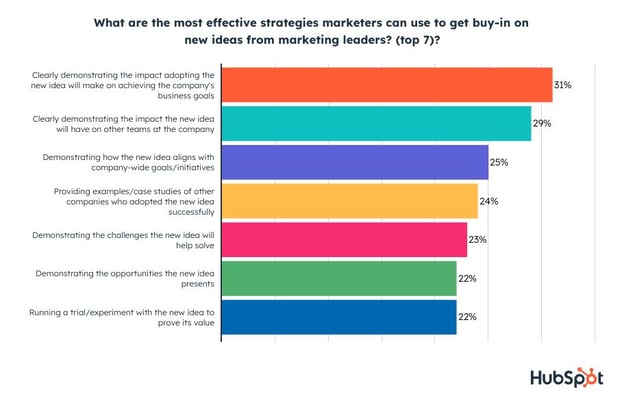
Demonstrating the challenges/opportunities the idea addresses and running a trial of the new idea to prove its value are also effective strategies.
Now that we’ve laid out the playbook for becoming an exceptional marketer and getting promoted, let’s dive into what it’s really like to be a marketing leader.
What Marketing Leaders Do All Day
If you’ve ever wondered what it’s like to be a marketing leader, or aspire to become one someday, we’re going to cover what you can expect in the role.
From their most important duties to the tools they use to accomplish them, let’s peek behind the curtain of what being a marketing leader is all about.
What are Marketing Leaders’ Most Important Duties?
Marketing leaders say empowering and motivating their team, short and long term planning, and analyzing/optimizing their media mix to maximize ROI are their three most important duties.
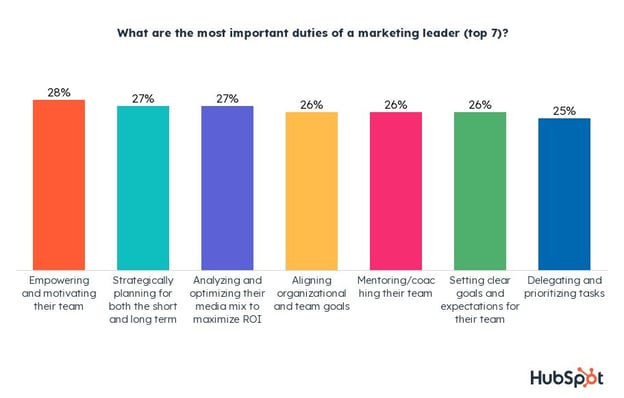
Aligning organizational and team goals, mentoring their team, setting clear goals and expectations, and delegating and prioritizing tasks are also crucial to their jobs.
Now let’s see which tools they use to accomplish their goals.
The Most Important Tools Marketing Leaders Use
Marketing leaders say their CRM is the most important tool they use when it comes to the overall success of their marketing activities. 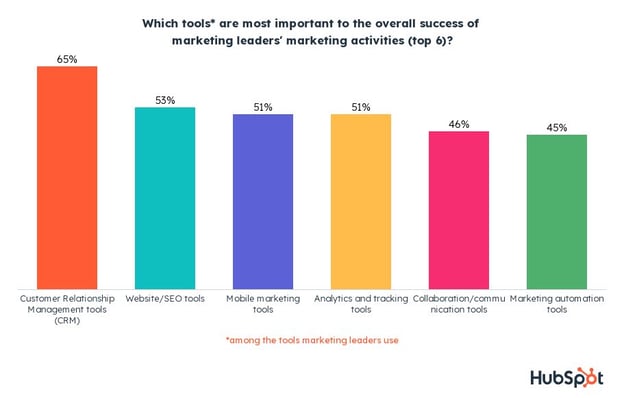
Website/SEO tools, mobile marketing tools, and analytics tools are also highly important to marketing leaders’ success.
Let’s take a look at how exactly they measure that success next.
How Do Marketing Leaders Measure Their Performance?
Marketing leaders measure their performance by tracking how often they engage with their employees, their teams’ productivity, the performance of their direct reports, the ROI of their programs, turnover/retention rates, and through employee satisfaction surveys.
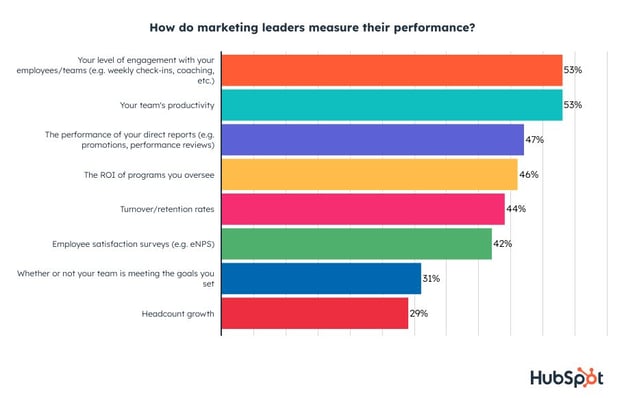
Finally, let’s wrap up by looking at the workload of marketing leaders and their teams, so you can see what it really might be like to be in their shoes.
What Does a Marketing Leader’s Workload Look Like?
70% of marketing leaders say their workload was high this year, and 40% expect it to increase in 2023.
The average marketing leader manages five marketing teams and 38% expect the number of teams they manage to increase in 2023.
Not only do marketing leaders have high workloads, but 2 in 3 recognize their marketing team has a high workload too, with one in five saying it is “very high.” Additionally, 40% of marketing leaders predict the workload of their team will increase in 2023.
On average, marketing leaders are working on 7 campaigns per quarter, and expect the number to rise to 9 per quarter in 2023.
Unlocking Your Inner Leader
Now that you’ve learned about a handful of data-backed strategies used by today’s marketing executives, hear more from thought leaders and other experts in the marketing field with the rest of the content in our Executive Leadership Report: Act Like a Leader, Think Like a Leader.
![]()



